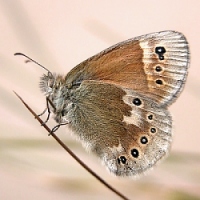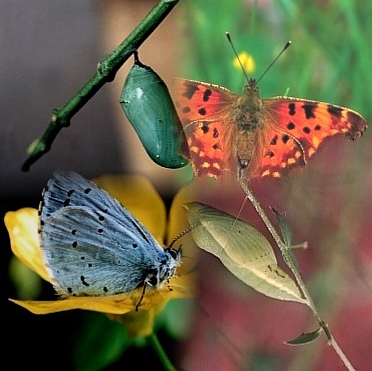IRELAND’S BUTTERFLIES
The Guide to Ireland’s Butterflies chart may be purchased using this link Butterfly Chart
Butterflies are sensitive to change and loss of habitat and to climate change and to alteration their environmental conditions and to the disappearance of their food plants, So they are considered to be good “indicator species”. There has been a large decline in numbers for many butterfly, as for other invertebrates, due to change in land use, loss of flowery meadows and decline in food plants essential for development of butterflies through the larval (caterpillar) stage of their life cycles. The widespread use of herbicides and insecticides is clearly a major element in their decline.

Species of particular concern are the Large Heath which has suffered a large decline due to the destruction of their habitat as a result of drainage and peat extraction from raised bog and changes in management practice for blanket bog. Despite recent efforts to “restore” bogs, such loss of habitat which has taken thousands of years to grow is essentially irreversible.The Marsh Fritillary, a species of damp habitat, has disappeared from much of Western Europe and the remaining colonies have become very vulnerable because of isolation and fragmentation and land ‘development’.
1970 to 1980
The first surveys of the butterflies of Ireland were compiled by the Biological Records Centre of An Foras Forbartha and the final version was published in 1980 (E Ní Lamhna). A very major contributor to these Atlases was Paul Hillis who did extensive field work and encouraged other recorders. Important contributors were Sean Fleming, Patrick O’Mahony, the Cork Naturalist Association, Ian Rippey, Robert Nash and Ken Preston.

1998 to 1999
During this period the Dublin Naturalists’ Field Club (DNFC), in co-operation with Butterfly Conservation (UK), collected butterfly records from recorders all over Ireland backdated to 1995. The data collected during this time was used in the production of The Millennium Atlas of Butterflies Britain and Ireland (Asher et al.) which was published in March 2001. In the short space of two years, assisted by many butterfly enthusiasts, we collected a very substantial amount of information on the occurrence and distribution of the butterflies of Ireland. Our efforts received the support of the Heritage Council.
2000-2004
The results published in the Atlas were very encouraging but still were very much a beginning and showed that much more systematic work was needed in order to build up an accurate picture of the habitat, distribution and frequency of all our butterfly species. So we extended our survey to include the period 2000 to 2004 and the results were published as a Millennium Atlas update – State of Butterflies of Britain and Ireland, in May 2006.
2015+
The Field Club completed its survey and 2014 was the final year of the five year cycle of 2010 to 2014. The identification chart Guide to the Butterflies of Ireland has been revised with a number of changes.
Ireland’s Butterflies A Review (David Nash,Trevor Boyd and Deirdre Hardiman) was published by the Dublin Naturalists’ Field Club in 2012 and includes information gathered for the period 1995 to 2009 for all Ireland.

The Essex Skipper arrival in Co Wexford is shrouded in mystery and it is not clear whether or not it is a deliberate introduction. Despite predictions it does not appear to have spread outside the county. The Small Skipper Thymelicus sylvestris colony in Co Kildare is apparently the result of a local escape or deliberate release.
Recent Publications
The recent publication, by Peter Eeles, of the Life Cycles of British and Irish Butterflies, Pisces Publications and Butterfly Conservation (2019), ISBN 978-1-874357-88-9, is a very interesting work and a very good read. Of general interest is its treatment, for example, of the dramatic decline of the Wall (= Wall Brown) Lasiommata megera in Britain and Ireland. Of specific Irish interest is his account of the Wood White Leptidea sinapis and the Cryptic Wood White Leptidea juvernica, the latter being the only Irish butterfly species not found in Britain.
